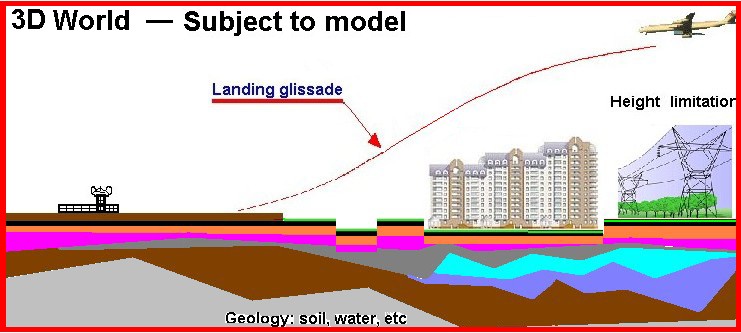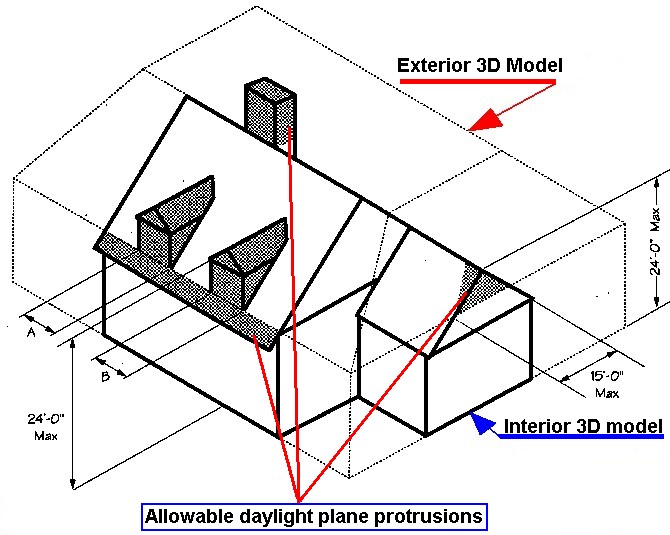| Fatekh Vergasov, Ekaterina Vergasova | |
| Matryoshka - 3D technology ADT versus Revit | |
|
Real life is three dimensional, real building codes and regulation are 3D too.
And it’s natural to assume that the better way to present it is in a 3D model.
As it was shown in my earlier work, there is no alternative to a 3D modeling.
Latest news in the world of 3D projection forced me to take a closer look at the technology of projection, the beginning point of which is creation of a 3D model.
Projecting from 3D, as well as the place and purpose of this technology during the whole life cycle of construction - from the idea coming into life to the use and maintenance with remodeling and utilization of construction garbage. This way I’m talking about a 4D model, i.e. 4D=3D + Time.
There are a few reasons why this technology should be considered:
First of all, because this approach was not obvious for all 100%, when it’s advantages were still unquestionable. I found too much false momentum and simple ignorance, as I became a witness of discussions of various architects and building professionals on this subject.
Secondly, it’s clear that this approach is impossible to realize without the use of the latest and most expensive hardware and software as manipulating only a part of a 3D model, justifying it by the absence of the right equipment means to emasculate an to castrate the 3D idea itself. And finally, there is no clear understanding about the subject of projecting. Is it only the house or a building? Realities of life, that were put together and created into a constructive and other norms of projecting, standards and other instructional documents, clearly state that the subject itself is the whole 3Dcomplex, which includes: geological data, landscaping, air space and society. There comes the logical and a little forgotten purpose of projecting – to put the desirable constructional object into the existing natural and social complex. Ignoring it, with present democracy and local government, would be kind of difficult. The customer wants to build effectively. He’s trying to use the volume of the lot to the max, including the air space above him and the underground space beneath. On the most expensive lots the buildings are trying to touch stars and reach to the middle of the earth. The way up is usually limited as well as the way down as the “Law on bowels” starts to take effect. Presence of the competitor recovers game and develops ingenuity This past spring AutoDesk experienced movement. Here one could also hear words about understanding the exclusive systemized approach of acquisition of the case of drawing instruments, which is more important than the function of every single one of them. This was an obvious reaction to the Revit Company, which has essentially overtaken the market of the “fatty” competitor. It was followed with suspiciously fast absorption of the company of the competitor. This bargain has caused many questions. Aren’t they going to choke on it? Will they manage to digest the swallowed? Will it go sideways? Behind which product is the future? Architectural Desktop or Revit?At first the absorption of Revit was perceived as the usual tactical dodge on neutralization of the competitor. Such as Stalin’s "to stifle in embraces". Then we took a closer look at the purchase. We liked it. The only thing we didn’t like, is that the dwg format was not supported, which we already used for so much! We can’t just throw it away! I can’t wait to please you though – just a few days ago came out the fifth edition of Revit with a full support of this format. So the continuity is provided.Before the fifth edition of Revit, the purchaser did not cease to obscure about the future destiny of architectural package – their own and the acquired one. There was a rumor that AutoDesk postponed the release of the 4th edition of the case of drawing instruments till the spring 2003. I started to have an impression that they were not so happy with the purchase. It’s like buying a suitcase without a handle – it’s hard to carry but pitiful to throw away. When I finally got to use the Revit package, I realized that AutoDesk made another move in the right direction. I don’t want to discuss the economical side of the deal, so under the “right direction” I mean making progress in "computer thinking" and leaving the old one behind. It’s when they offered the public more or less ordered sets of drawing tools and instruments. Architects from the former USSR are unaware of the danger of “computer thinking”. They didn’t get a chance to know it due to the virtue of the fundamental reasons of living. Every cloud has a silver lining :-)
However, in the near future, projecting, coordinating
and building will depend on 2D So we’re not going to be without them for a while, but it does not mean at all, you should spend unfairly a lot of time and means with 2D drawings. They are not worth it because it’s not a fantasy anymore to supply all the general contractors and people occupied directly with the construction with portable PCs, notebooks, and even palm pilots, which will allow them to easily manipulate a 3D model of a certain building object and the constructional site in general. By the way 3D printers already exist, which quickly allow to create a
3D model with a given scale. Such models are very useful in discussions
when different concepts are being offered. The authorized concepts can
"be printed" on 3D printers in necessary quantities, so that all
the participants of construction can get acquainted with them, not just
the supervisors. This will create more order of things. The main advantage of Revit – the parametrical modeling Don’t be afraid of this phrase. Behind it is the ordinary order, in sense of orderliness of the Whole and Private. In brief, all elements here - essence parameters: 3D model, its components, 2D model (that the drawing usually refers to), various data tables, etc. I shall remind, that by definition, parameter refers to such characteristic which is set not by a singular but by a minimum of two numbers within the framework of which numerical value of the characteristic can change under one or another law or be set individually. Such characteristic which sets not a singular and as a minimum two numbers within the framework of which numerical value of the characteristic can change under any law or be set any way refers to as parameter. Parameters here are fastened among themselves in such hierarchy (a pyramid, a network, etc.) where any element of system if necessary can be appointed at a choice " top of a pyramid and the ruler of destinies” where everything else directly depends on it. By the way, I shall remind that by definition, such characteristic which sets not a singular and as a minimum two numbers within the framework of which numerical value of the characteristic can change under any law or be set any way refers to as parameter.
Don’t be under a delusion though, that this will allow to get rid of mistakes. Mistakes too, "will be coordinated" by system if necessary terminators are not placed. But there is hope, that released from routine work, architects will spend additional time analyzing the project in attempts to find out the main mistake which quite often is made in choosing the right profession. The next difference of Revit is in their consistent and essential adhering to the concept “from 3D to 2D to drawings", not the other way around. In other words, they force the architect to be engaged in his direct duties, and not in the form, beauty, space, light, wind, landscape, etc. When they get engaged in all of the above, projecting becomes sort of this passing thing, sort of along the way. Architects are not very delighted with this idea, softly speaking. Other compared properties of architectural software of both companies are approximately identical or essentially indiscernible. They both have in common an incomplete understanding of the problems and tasks of designing itself, where the project itself demands more than the work of the architect. (Look in the beginning of the article, the third reason of necessity of consideration.)The details of the project depend on the way of organizing the construction If the general contractor suffers from "managing itch" and is going to supervise the subcontractors on a building site, he orders very detailed drafts. Frequently it leads to ridiculous situations. Once upon a time our soviet architects brought to Iraq the whole container of drawings of compressor station. The foreign Customer has offered to spread out drawings on a floor in a sports hall of a local school. From a huge number of drafts the representatives of the customer picked out only a few plans: the general plan, facades, and the individual store plans. Our architects were very surprised. The customer replied: - I have specialists working on this projects and professional subcontractors, and they don't need every window and every door on the prints - Yeah! But what about tying the project with the equipment? - We'll figure it out. It's not our first time. - But what about the specific work - electricity, the water drain, networks, etc.? - Same way. - We can't do it! We have building standards.... - Let's just sign the contract and you'll get your money. And say thanks for not charging you the rent of the facility and taking all your endless drafts to the garbage can. - Thank you.That's how the administrative system faced the market. In the beginning, being ignorant, I started to preach the Soviet system too as I came to US . But has quickly changed. Detailed drawings as appeared, are not necessary for anybody here where the certified and licensed companied do the work. By the way, a "company", as a rule, is very narrow specialized, i.e. carries out only one kind of works. For example, puts wooden fences, covers a roof with a tile and is usually consists of one person - a self-employed man. This guy is similar to the regular contractor, but his own company will have all the necessary tooling, adaptations and mechanisms for performance of a certain kind of works. The company bears the responsibility for its activity, so upon receiving its licenses the owner buys the insurance policy that will cover in case of fault, in causing damage or losses. Many companies have a solid insurance covering from all kinds of accidents. Actually, the art of being a general contractor is in being able to select a group of insurance companies, whose policies all together would cover all possible omissions, losses and damage from the activity of builders, but no more than a week. (It's common here to be paid weekly). There are tons of companies on the market, so there is no problem with selection. Just like back in the days of communism - the offers come before demand. These companies do not need any detailed drafts Usually all they need from a general contractor is the amount of work and the time frame. At this point even the price quote is not necessary, even though the current price ranges are known to the general contractor as at the planning stage they'll count everything in such a way: the highest prices possible + 25% mark up. The real market price, and that's why it's called the market price, is determined in one certain deal. Smart people always expect the worst outcome, so that if a prediction will not come true they will be pleased. Fools on the other hand are always delighted in the beginning but get burned in the end. Moreover, a smart general contractor will never try " to rearrange legs " to the subcontractor and to specify to him how to perform this or that work. Otherwise all risks, and the main thing, the responsibility will lie on his shoulders. Here they already got rid of these kind of guys. They prefer to pay these guys a pension so they don't ever show up again. At some point I found myself engaged in calculation of materials - what a waste of time. The economy has not justified work on calculation. Suppliers, certainly can sell to you, for example, two pounds of nails, but you'll pay a little bit less than the price of the whole 20 pounds box. Same thing with all other materials, because nobody will have an expensive work force for opening original factory packages. It may seem that there is no struggle for economy of materials. This way they save the labor, here and now, since the last work is already paid for, money spent, waste products of life are utilized. This way the market economy turns and spins and this cycle is stimulated not by the political information prior to the beginning of works and "pumping up" the management, but by simple desire to eat. Here everyone knows, that from laziness one gets very hungry. Yet there is nothing to eat. Let's go back to the details of drafts. Understanding the statements above, the City has rather the modest requirements to blue prints in a sense of how detailed they are. General plan, individual store plans....just like once in Iraq. The market economy works the same everywhere. I have told about the details of drafts only to cool the excessive enthusiasm and noisy energy of those who has concentrated on putting little tiny details such as furniture, windows, doors, etc. on their drawings. At all doubtless importance of these details, it's not here where " the dog is buried " Problems of company merging After Revit was bought out, the professionals of the industry are busy disputing the further destiny of two main architectural products from AutoDesk and Revit. However after the recent release of Revit's fifth edition and the announcement about complete support of a dwg-format, the architectural community calmed down. Looks like they ordered the fifth edition; they'll study it closer, and then..... Support of a dwg-format shows that the "digestion" of what's been swallowed began. What will happen and who will get ahead will remain unknown before the release of ADT's new fourth edition which is planned for March, 2003. Truthfully, there is a rumor that AutoDesk is planning to develop both of the architectural lines. But why splitting such a not numerous architectural community?! Meanwhile, it is clear to everyone that they will try to develop two bears living in one den. As a result a certain successor will be born who will hopefully inherit only the best features of the parents, which is not always the case. We'll see..... In such conditions the third reason specified in the beginning of article becomes important
Therefore, I think a time has come to generalize all these requirements so that in a new fashion we can formulate the concept of the subject of designing from a position of a 3D modeling. Otherwise it is not clear, what are we trying to model and what concepts to follow. Without a clear understanding of the subject of designing it is impossible to perfect neither Revit no AutoCAD5. Therefore it makes sense to repeat once again the obligatory parts of a 3D model of a site of construction with adjoining next built up platforms. 1. The geological environment: actual geology, underground constructions, engineering networks, lines of underground, pipelines, cables, channels etc. etc. not to overlook the root systems of the large trees that are subject to preservation, and the hydro-geological data. 2.A geodesy, i.e. necessary kinds of geodetic shots of a landscape, and also hydrological researches of a superficial drain. 3. Air space. Light and shadows, position of the Sun and the Moon, possible (probable) lines of flying devices, for example.
Some start to protest. Why building a 3D model of district? Isn't it easier to keep all the legislative restrictions in mind and start projecting right away? You can, but it's not the best way. Here's why: 1. Norms and restriction have a huge amount of exceptions. Moreover some exceptions which are included in a prerogative of local self-government institutions can "be planned" and approved ahead of time. This way a 3D model can exceed the framework of an external 3D model of a district. Such outputs - breaks of an external environment - are easily fixed, but are difficultly measured. There are no 3D tools for such work. 2. External 3D model of a district in relation to a projected object plays a role of the testing tool without which it is difficult to supervise a stretch of imagination of the developers armed with the tool of parametrical modeling. 3. Presentation is lost. It becomes difficult to prove, that norms and restrictions are observed. So the time of approval will inevitably be delayed. It is necessary to keep in mind that public frequently likes to participate in the coordination of the project, the big part of which( the public) are not always the experts in this matter. Presentation in these cases frequently plays a main role in reception of the necessary coordination and approval. Besides presentation does not give bureaucrats an opportunity to be engaged in red tape and extortion of bribes. 4. Additional expenses connected to the creation of a 3D model of a district (which borders in each particular case are determined by normative documents) will be justified repeatedly due to a solid economy of work of designers and due to effect of pre-scheduling of objects being built. Russian Nestling Doll - Matryoshka - design technology
2. The external model will carry out not only the role of an invisible border , but also should have properties of the measuring tool which would automatically give out numerical values of all of " breaks of an environment " of a model. Thus the external model not only will show such a "break", but will also give its numerical value that will allow us to compare it to a normally accepted decision. 3. The technology of designing by embedding objects in existing 3D models in reality will provide both continuous and uninterrupted consideration and the coordination of projects, and the most important, conflict-free construction, accident-free operation, and also demolition of the existing object and recycling of building dust. Such embedding is the real work description of the architect working in the real city and in the real neighborhoods. |
|

 It means here, that it is possible to make changes to any parameter,
and such changes synchronously and immediately will have an effect on all
other elements of the system. The offered mutual coordination of system of
parameters is very convenient, since it removes the headache of figuring
out the coordination of separate elements after making change to one of
them. Rubik's Cube is remembered for having this property.
It means here, that it is possible to make changes to any parameter,
and such changes synchronously and immediately will have an effect on all
other elements of the system. The offered mutual coordination of system of
parameters is very convenient, since it removes the headache of figuring
out the coordination of separate elements after making change to one of
them. Rubik's Cube is remembered for having this property.

 1. It is necessary to build not one but two 3D models -
1. It is necessary to build not one but two 3D models -